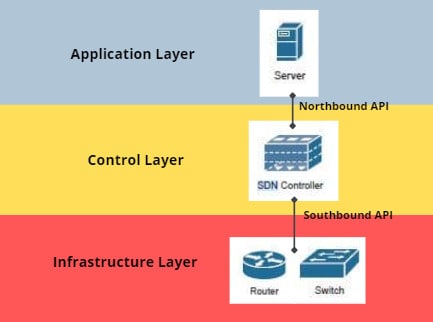The future of data networking is automation. In a traditional network, we are managing the network devices like routers and switches using the box-by-box method on CLI or GUI using SNMP, SSH, or telnet. Also, on the new deployment of the network devices, it starts with minimal or no initial configuration. Those lapses from the traditional way of managing and optimize network resources are solved by using Software Defined Networking (SDN).
What is Software Defined Networking (SDN)?
Software-Defined Networking (SDN) is a technology for network control and management that enables dynamic and programmatic approaches to network monitoring and configurations. With SDN, network operators or engineers can modify and control the traffic from the centralized controller without touching the individual routers and switches on the network. It can also do the dynamic implementation of the initial configuration by using plug-and-play provisioning. SDN also automatically updates the changes in configuration based on the pre-defined policies configured on the SDN controller.
The applications that are hosted on the servers in an SDN architecture that manages the control for all the devices on the network to simplify and improve network management and performance is called the SDN controller.
Router and Switch Planes
Network device functionality is divided into three which are data plane, control plane, and management plane.
1. Data Plane
Also called forwarding plane. It is the traffic that is forwarded through the network devices. It is responsible for transporting the network traffic through the network. The traffic travels through the network device rather than from or to the network device. A common example of a data plane is matching the destination IP address to the IP routing table of the router.
2. Control Plane
It decides on how to forward the traffic or act upon specific traffic that the router is processing. Common examples are building IP routing tables and routing protocols, switch MAC tables, ARP, and STP.
3. Management Plane
It contains the protocols that allow the network engineer to manage the network devices. Common examples are CLI using SSH/telnet or GUI using HTTP/HTTPS.
Software-Defined Networking (SDN) Basic Operation
In traditional network services, all three planes are implemented in the firmware of network devices located on the data center. On SDN, the control and data planes are separated. The Data plane is still implemented on network infrastructure devices while the network control plane is implemented in software that is hosted on a server, which enables the dynamic and programmatic approach of managing network devices.
The SDN controller sends the policies or rules like dynamic updates and configurations to the network devices. On the other hand, the network devices send a query to the SDN controller on how to handle the packets.
Software-Defined Networking (SDN) Architecture
SDN architecture is divided into three layers – the Infrastructure Layer, the Control Layer, and the Application Layer. By the use of API, we can be able to connect the layers in SDN architecture. The layers are hierarchical. The infrastructure layer is placed at the bottom of the SDN architecture, and the control layer is placed at the center while the application layer is placed at the top.
Hence, the link between the infrastructure layer and the control layer is using a Southbound API, and the link between the control layer and application layer is using a Northbound API. Southbound API allows the controller to program the data plane forwarding tables of the network device.
Common examples of southbound API are OpenFlow, SNMP, REST, NETCONF, SSH. Northbound API typically uses REST API in which applications tell the network what they need, like data, storage, or bandwidth. The below image shows the SDN architecture.
Download our Free CCNA Study Guide PDF for complete notes on all the CCNA 200-301 exam topics in one book.
We recommend the Cisco CCNA Gold Bootcamp as your main CCNA training course. It’s the highest rated Cisco course online with an average rating of 4.8 from over 30,000 public reviews and is the gold standard in CCNA training:

